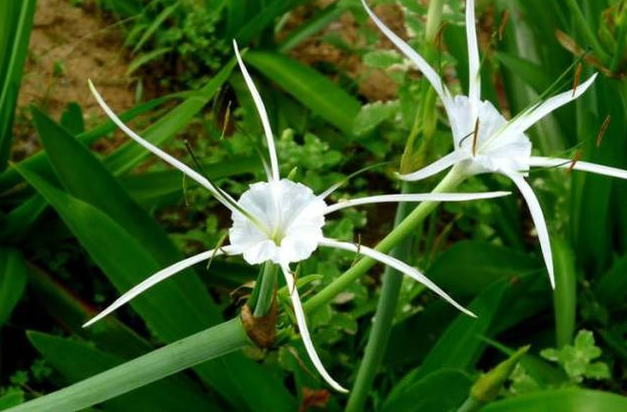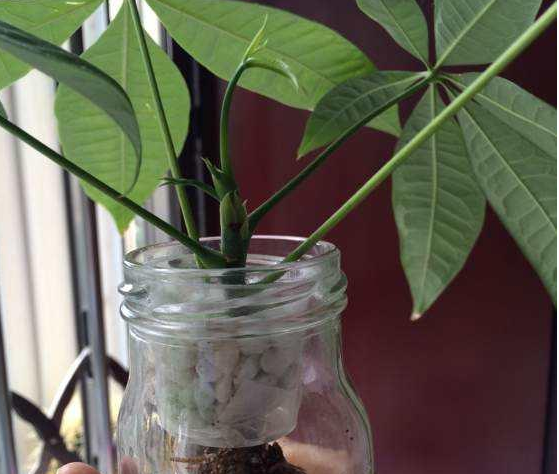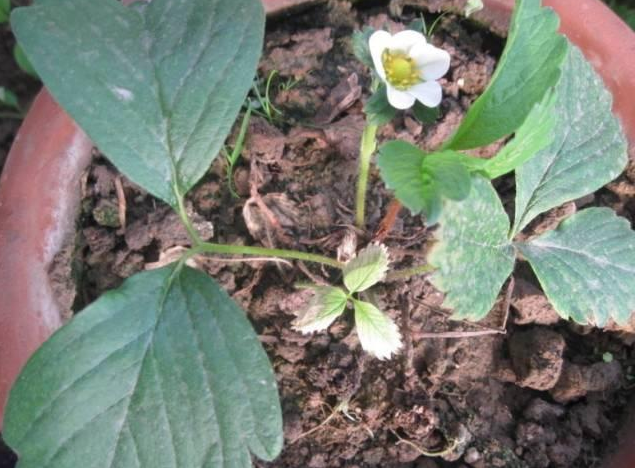The difference between the culture methods and matters needing attention of spider orchid and Wenshu orchid
Spider orchid, upon hearing this name, do you think it has anything to do with spiders? it really has nothing to do with spiders. Let's take a look at the breeding methods and precautions of spider orchid. What are the differences between Spider Orchid and Wenshu Orchid:

Culture methods and matters needing attention of spider orchids:
1. Lighting
Like plenty of sunshine, slightly shady, except summer high temperature at noon, other times can be placed in a place with plenty of light for maintenance. Like warm, slightly cold-resistant, the suitable temperature for growth is 20 ℃ ~ 25 ℃, about 5 ℃ can survive the winter safely.
2. Moisture
Like moist, afraid of waterlogging, slightly resistant to drought. The amount of water can be increased with the increase of air temperature in spring, once a day is appropriate, watering times can be increased in summer, and it can be watered thoroughly in the morning and evening. High temperature in summer should increase ventilation while increasing humidity, otherwise it is easy to rot, after autumn, the temperature decreases, it is necessary to keep it a little dry in winter, and the overall watering does not accumulate water. To the extent that there is no drought.
3. Soil
Like acid sandy loam which is rich in humus, loose, fertile and well drained. Compound fertilizer or cake fertilizer and water were applied once every half month during the growing period. Manure, phosphorus and potassium fertilizer were applied every 10 to 15 days at flowering stage to promote flowering. Stop fertilizing during dormancy.
There's another interesting thing. The design triggered by the spider orchid-the Burj Khalifa, the tallest building in the world.
The design of the Y-shaped floor of the Burj Khalifa is inspired by the desert flower spider orchid, which maximizes the integrity of the structure and allows people to enjoy the charming scenery of the Arabian Gulf. In the center of the building, there is a hexagonal "supporting core" with reinforced concrete structure. The floors are arranged in a spiral and can withstand the raging desert storm. The award-winning design of Burj Khalifa inherits the unique style of Islamic architecture.
The difference between Wenshu orchid and spider orchid:
1. The similarities between Wenshu orchid and spider orchid
Wenshu orchid and spider orchid are orchid plants, their flowers and plants are very stout, extracted from the leaves, by many flowers in umbels born at the top of the flower extract, are white.
Both Wenshu orchid and spider orchid have strong tillering ability, and young root rayon seedlings can be sprouted on the stem disk of perennial plants, which can be divided and planted separately. When dividing, there is no need to take off the basin, when the root seedling grows to about 15 cm, first loosen the surrounding basin soil, and then use a knife deep into the basin soil to cut it from the part connected to the stem disk of the mother plant, which can be put forward together with young roots. It is not easy for millet seedlings without young roots to survive after planting.
The growth rate of Wenshu orchid and spider orchid is fast, and the four-year-old ramet seedlings can grow into large pot plants with a diameter of up to 50-60 cm. Family training in order to control growth in order to facilitate display, try not to plant large pots, and do not turn pots to change soil year after year, as long as you keep the pot soil moist, you do not need to fertilize. They are all negative plants, outdoor furnishings must be shaded, and the leaves will scorch after being exposed to the hot sun for an hour. If you move into the room in the first and middle of October, you will not be frozen at a room temperature of no less than 6 ℃.
2. The difference between Wenshu orchid and spider orchid
Wenshu orchid and spider orchid are not plants of the same genus, and the main difference between Wenshu orchid and spider orchid is that the leaves of Wenshu orchid are dull, the whole leaf is undulating and wavy, and the apex is acuminate. The leaves of spider orchid are narrow, the leaves are flat and sword-shaped, and the surface is shiny.
This is the end of the introduction of the breeding method of spider orchid. Although this spider orchid and Wenshu orchid are similar, there are still differences. We should pay attention to the distinction.
Control methods of Leaf Blight of Water Ghost Canna
Water ghost banana is also called spider orchid. Water ghost banana not only has ornamental value, but also has high medicinal value. It can also be cultivated in a large area as an economic crop. Planting in a large area will cause diseases. Today, we introduce the prevention and control methods of banana leaf blight.
Symptoms of water ghost banana leaf blight leaves infected with small erythema or injury spots, mostly along the longitudinal expansion into a larger round spot, brown, serious leaf dry. There are brown spots on the spot. Flowers and bulbs also show light brown to dark red spots, causing pedicels to dry or no longer grow flowers. In addition, the broken tissue after the spider orchid injury will also turn red after seeing the air, which is the special performance of spider orchid, Wenshu orchid, Zhu Dinghong and so on. Attention should be paid to the difference between pathogens.
Pleurocytospora sp, the pathogen of banana leaf blight. It is called a kind of coccidiospora, which belongs to semi-known fungi. Conidia dark brown, oblate to flask-shaped, initially buried, orifice exposed after maturity, size 190 ~ 339.6 × 150 ~ 165 (μ m), solitary or multiple aggregates, some multi-chambers, multiple single chambers when mature. Conidiophores colorless, branched at the base or upper part, 12 ~ 24 × l ~ 1.5 (μ m). The single cell of conidia is colorless, straight or slightly curved, blunt round at both ends, sausage-shaped, size 3.8 ~ 6.3 × 1 ~ 1.3 (μ m).
The pathogen of water ghost banana leaf blight overwintered in the diseased tissue with mycelium or conidia, and the conidia were released in the next spring to spread by wind, rain and watering, invading from micro-wound and carrying out primary infection and re-infection. Wet and rainy weather is easy to occur and expand, which occurs from January to November every year. It can occur all year round under the condition of shed.
Control methods of Leaf Blight of Water Ghost Canna
The main results are as follows: (1) when changing the basin in spring, we should apply sufficient base fertilizer and put it under the shade shed, apply fertilizer in time during the growing period, strengthen indoor ventilation, avoid direct sunlight and maintain a certain humidity. It is found that the disease spot should be cut off in time, watering from the edge of the basin, do not drop water into the heart leaf, often clean the leaf dust, keep the leaf surface bright, and reduce bacterial infection. When the orchid enters the dormant period, watering should be controlled.
(2) if necessary, spray 1000 times of 50% water-soluble powder or 40% chlorothalonil suspension, 30% copper chloride suspension, 40% polybromofumarate wettable powder, 80% Fu-Fu zinc (Luheng 2) wettable powder, once every 7 to 15 days, control for 3 times.
Have you learned the prevention and control methods of water ghost banana leaf blight? For more information about Shuighui bananas, please pay attention to the hot agricultural materials.
- Prev

The method of cuttage propagation of rich trees can also be cut with water.
Fortune tree, this is a very auspicious plant, many people in the family have farming in their homes, let's take a look at the method of cutting propagation of wealth trees: concise version: directly use water cuttings to select healthy and harmless branches of wealth trees and directly insert them into glass cups of water, change the water every three days
- Next

Planting methods of potted strawberries planted on balcony
Strawberries, which are loved by many people, are now living in tall buildings. What if you want medium strawberries? There is only potted planting, let's take a look at the balcony potted strawberry planting method is what? Balcony potted strawberries in which month: balcony potted strawberries planting method: 1. Planting time
Related
- Fuxing push coffee new agricultural production and marketing class: lack of small-scale processing plants
- Jujube rice field leisure farm deep ploughing Yilan for five years to create a space for organic food and play
- Nongyu Farm-A trial of organic papaya for brave women with advanced technology
- Four points for attention in the prevention and control of diseases and insect pests of edible fungi
- How to add nutrient solution to Edible Fungi
- Is there any good way to control edible fungus mites?
- Open Inoculation Technology of Edible Fungi
- Is there any clever way to use fertilizer for edible fungus in winter?
- What agents are used to kill the pathogens of edible fungi in the mushroom shed?
- Rapid drying of Edible Fungi

